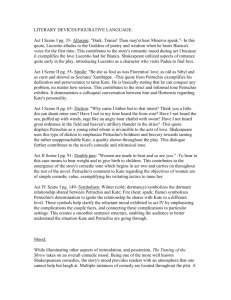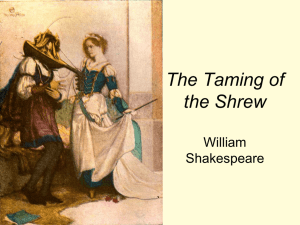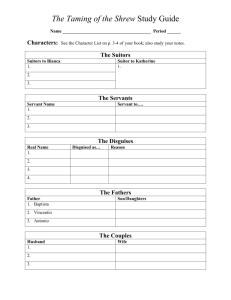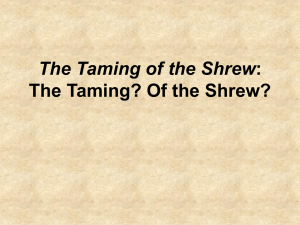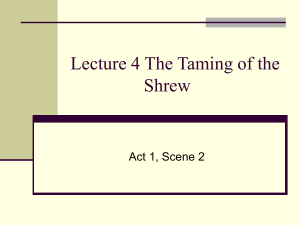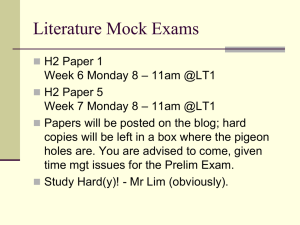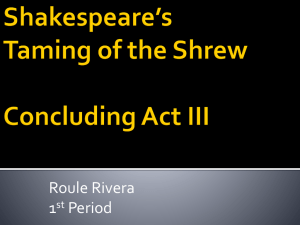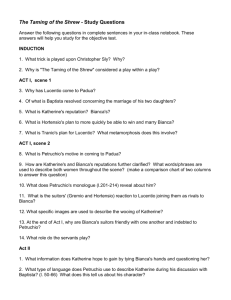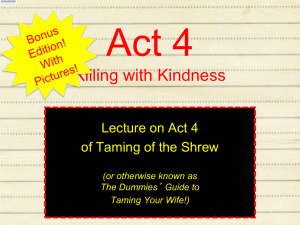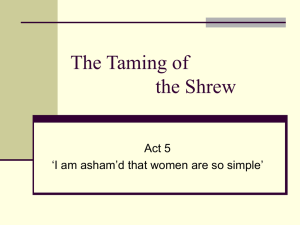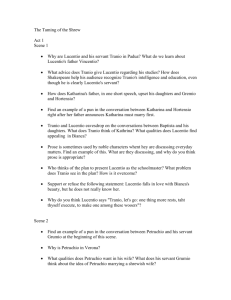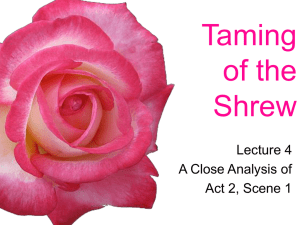Lecture 7 The Taming of the Shrew
advertisement
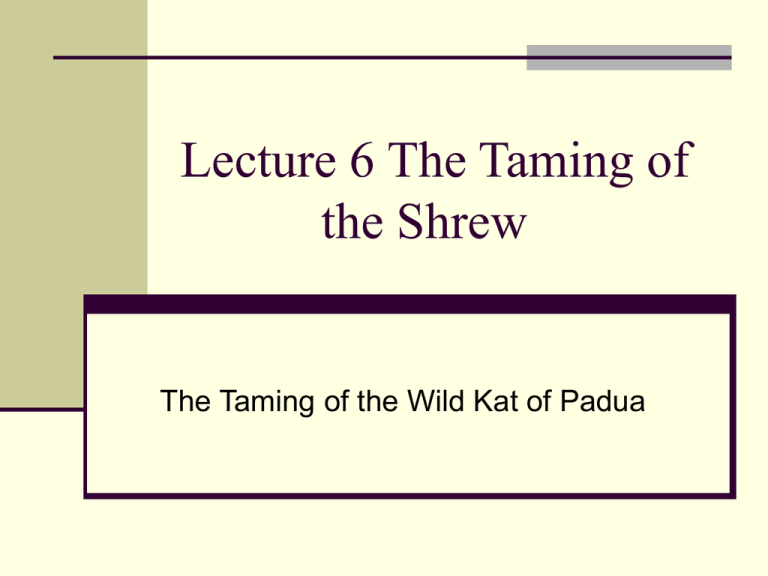
Lecture 6 The Taming of the Shrew The Taming of the Wild Kat of Padua Representations Roles Relationships Petruchio is the hero of a farce; Kate is a farcical shrew; tone We should view comic scenes as far as possible in the light of common experiences of 16th century spectators; The play’s attempt to produce laughter would inevitably take into account the comic expectations and inclinations of audiences of its age / period Shakespeare not only included mental dexterity in the dialogue but also showed a red-bloodedness that played up to and appealed to the laughter and merriment of the “vulgar” This Included aspects of comic wooing emphasized by shrewish wives and noisy, brawling females Rival perspectives re its comedy Burton Raffel: Whether we ourselves happen to be male or female, We can and should laugh (as we are meant to) At both Petruchio and Kate without the slightest concern about compromising our gendered condition or status; Laurie Maguire, critic: As a woman, I cannot find the subjugation of a wife fit matter for comic treatment. Some general prefacing comments What Shakespearean comedies seem to have in common? A preoccupation with the journey of young women From a state of virginity To a state of matrimony From parental control (Patriarchal control) To matrimonial control (Patriarchal control)) General observations cont The play develops from two primal images: the shrew and the hawk; (one an animal; the other, a bird); ‘Shrew’ imagery dominates the first half of the play (Act 1 to Act 3); Petruchio’s first soliloquy, 2.1.168-181 outlines his plan for dealing with his ‘shrew’; But his soliloquy says nothing about the actual taming of Katherina; The only bird mentioned is a nightingale The actual ‘taming’ image, the ‘hawking’ imagery, of reclaiming the haggard, dominates the second half of the play; from Act 4 to Act 5; Comments (cont.) The first three Acts explore the peculiar characteristics of the shrew Ranging extensively through the analogies between human and animal behaviour The last two Acts focus intensively on the single action of manning a wild hawk Translating it forcefully into human terms What unites the two symbolic patterns: ‘Shrew’ and ‘Taming’ (at a deeper level?) The concept that all life is a contest The battle of opposing wills The noisy, fighting shrew opposed by another of her kind ‘He is more shrew than she.’ 4.1.72 The battle of opposing wills Between a wild bird, and its tamer The result? A resolution of the conflict Through a peculiar kind of peace; Act 3 Scene 1 Gender Issues? The Lucentio Wooing Scene The wooing of Bianca in sub-plot Contrasts with the wooing of her sister, Katherina, in the main plot Bianca’s wooing / courting? More than one wooer vie for her attention; Wooers are in disguise; Lucentio as Cambio Hortensio as Litio And ironically, they do not have the upper hand in the way Petruchio does in the Main Plot; indeed it is quite the opposite; Bianca: Appearance and Reality Bianca shows she possesses a strong will A strength of will that was not outwardly apparent ‘Why, gentlemen, you do me double wrong To strive for that which resteth in my choice. I am no breeching scholar in the schools: I’ll not be tied to hours nor ’pointed times But learn my lessons as I please myself. And to cut off all strife, here sit we down. Take your instrument; play you the whiles; His lecture will be done ere you have tun’d. 3.1.16-23 Recall our question? Gender Issues? Does Shakespeare endorse patriarchy? Bianca in this scene decides to whom she will listen and from whom, and how much she will learn; She is the one in command; What takes place ironically contrasts with Petruchio’s wooing of Katherina in the Main Plot Hortensio and Lucentio attempt to woo Bianca through the conventions of courtly procedures— one using music; the other poetry; Her control of them comically and ironically echoes the control Petruchio attempts to exert over her sister; Scene explores deeper aspects of love and marriage; Bianca: Appearances and Reality? Bianca is not the ideal Renaissance woman she appears to be We are presented in this scene with the deceptiveness of appearances; Ironical her disguised wooers fail to see beyond her outward appearance The romantic approach to Bianca is undermined by the wooers themselves as they are taken in by her pleasing outward decorum and behaviour thus far in the play Bianca’s Latin lesson; Gender Issues? Bianca to Lucentio (as the tutor, Cambio): ‘Where left we last?’ Lucentio (as Cambio) to Bianca: ‘Hic ibat, Simois, hic est Sigeia tellus, Hic steterat Priami regia celsa senis. Bianca to Lucentio: ‘Conster them.’ Here ran the river Simois; here is the Sigeian land (Troy); here stood old Priam’s lofty palace. From ‘Heroides’ by the Roman poet, Ovid Is the Latin text from Ovid significant? These lines of Ovid come from the Epistle in which Penelope is imagined as writing to her husband, Ulysses, while surrounded by her unwelcome suitors; Link / relation to Bianca’s situation? Bianca is also surrounded by unwelcome suitors. Also, comically ironic? Wooing Bianca with this choice of poetry from Ovid. Why? Ovid’s poetry is more a cynical guide to seduction than a work of genuine romantic inducement. Lucentio reveals his true identity Lucentio addresses Bianca: Hic ibat—as I told you before; Simois—I am Lucentio; hic est—son unto Vicentio of Pisa; Sigeia tellus— disguised thus to get your love. Hic steterat—and that Lucentio that comes a -wooing; Priami—is my man Tranio; regia— bearing my port; celsa senis—that we might beguile the old pantaloon. (i.e. Gremio) Note Bianca’s reply; Significance? Bianca replies to Lucentio’s revelation (in the language of Prose): ‘I know you not; I trust you not’ [L 40-41] ‘In time I may believe, yet I mistrust.’ [L49] Bianca is not gullibly infantile in forming her beliefs; Indeed, she is being shrewdly cautious Lecture 6 The Taming of the Shrew Part 2 Lest we forget Let’s not forget the more immediate audience of the play; The characters for whom the ‘comonty’, The Taming of the Shrew is being performed; Recall the end of the Induction, Scene 2; Christopher Sly, and ? ‘Come madam wife, sit by my side, And let the world slip. We shall ne’er be younger.’ Act 3 Scene 2 The Wedding Scene Setting — Padua: Baptista’s house Contains many moments of great comic farce; Artificial presentation; full of ridiculous confusions The way especially Petruchio arrives; including his outrageous appearance; (Note his apparel) The important action (the marriage ceremony) takes place off-stage, and is reported by witnesses And the way Petruchio departs from the stage with his bride Playful Suspense Audience eagerly awaits Petruchio’s arrival Wonder how he will conduct himself? What sorts of things will he say and do? Why? Given especially his earlier on stage appearance and behaviour; Especially his entertaining, rough behaviour in the wooing scene; (Act 2, Scene 1) Recall his unconventional and blunt behaviour in the earlier wooing scene, The audience cannot help but think that things will not proceed straightforwardly and smoothly; Playing games is something that Petruchio does throughout the play, whether the games are funny or dark, and he sets the tone as soon as he arrives. Baptista speaking to Tranio as Lucentio Signor Lucentio, this is the ’pointed day That Katherine and Petruchio should be married, And yet we hear not of our son-in-law. What will be said? What mockery will it be To want the bridegroom when the priest attends To speak the ceremonial rites of marriage! What says Lucentio to this shame of ours? 3.2.1-7 While Katherina is being kept waiting, how does the audience see her? How does she look? Calm and collected? Or is she noticeably anxious? Supporting textual evidence? Katherina 3.2.8-20 No shame but mine. I must forsooth, be forc’d To give my hand, oppos’d against my heart, Unto a mad-brain rudesby, full of spleen, Who woo’d in haste and means to wed in leisure. I told you, I, he was a frantic fool, Hiding his bitter jests in blunt behaviour. And to be noted for a merry man, He’ll woo a thousand, ’point the day of marriage, Make feast, invite friends, and proclaim the banns, Yet never means to wed where he hath woo’d. Now must the world point at poor Katherine And say, ‘Lo, there is mad Petruchio’s wife If it would please him come and marry her!’ Interpretation of her behaviour Is what she says an indication that she quite sincerely wishes to be married? She does appear to be concerned about losing face And being a social disgrace ‘No shame but mine.’ Note also the last three lines of this speech; Gender issues arising here? Marriage; brides and bridegrooms? Petruchio’s fantastic clothing as he arrives at the wedding as described by Biondello; pg 59 Tranio’s comment makes a crucial point; ‘He hath some meaning in his mad attire.’ [3.2.118] What meaning is intended by this? Petruchio is playing the fool, and like Lear’s Fool in Shakespeare’s King Lear, Petruchio is presenting unpalatable truths under the cloak of entertainment. (Irony) Biondello’s speech in ‘translation’ Petruchio is wearing a new hat, and an old jacket; his pants are thrice repaired, his boots were once candle wrappings; his sword is a rusty relic from the town armoury, the hilt is broken, the scabbard has no metal tip; his lacings are frayed on the tips; his horse has a swollen throat and watery nose, the mouth is infected and filled with swollen glands; it has lumpy, tumorous legs, it is foul with jaundice and dying of lumps in the ears; reeling with brain disease, gnawed by parasites, sway-backed and shoulders out of joint, knock-kneed, the head droops from a half-attached bit and a bridle of sheepskin; to keep him together from stumbling, the harness has often split and been tied together, the belly strap has been repaired six times; it bears a tail bridle of velvet suited to a female rider, the length is studded, spelling her initials; the length has been darned with sewing thread. Sub-text? Is it Katherina who is ill-prepared for marriage? And Petruchio in putting on such foolishness and disgraceful behaviour, is telling her so. To ‘tame the shrew’, in one sense, is to what? to exorcize an evil and an irascible spirit in this case by outdoing it / outperforming it; Petruchio thus aims to kill Katherina’s evil and irascible spirit in her own wild humour And in another sense? To reduce a wild bird to obedience So that she can hunt for you and with you It is the taming image The reclaiming of the haggard Which controls the second half of the play Katherina is denied her bridal dinner in this scene And starved in Petruchio’s house in 4.1 Update on battle of the sexes From the courtship onwards, Petruchio has been in control of events That he refuses to stay for the wedding feast symbolically further confirms his authority over matters; (action as symbol) In spite of ‘entreaties’ to remain, from both Tranio and Gremio; And also Katherina’s ‘Let me entreat you’ Sub-text of repetition of ‘entreat’? Katherina will have to get used to giving in Gremio’s Report of the Mad Marriage Ceremony ‘Ay, by gogs-wouns! quoth he, and swore so loud That, all-amaz’d, the priest let fall the book, And as he stoop’d again to take it up, This mad-brain’d bridegroom took him such a cuff That down fell priest and book, and book and priest!’ ~~~~~~~~~~~~~~~~~~~~~~~~~~~~~~~~~~ 154-158 ‘This done, he took the bride about the neck And kiss’d her lips with such a clamorous smack That at the parting all the church did echo. And I seeing this, came thence for very shame, 171-174 Such a mad marriage never was before! 176 Critical Interpretation Gremio reports Petruchio’s behaviour at the marriage ceremony Through the dramatic technique of the displacement of the action on stage by instead an account of its description Reflects Petruchio’s displacement of the solemn union of this man with this woman With an exaggerated, mocking imitation of it This mock action symbolizes what he believes marriage to an unreformed shrew to be The Imagery of Woman as Owned Property by the Man The taming of his wife now becomes a serious business; Being her husband, he is now officially her owner; ‘I will be master of what is mine own.’ L-222 ‘She is my goods, my chattels;’ L-223 Katherina finally becomes his ‘household-stuff’ L-224 The brutal realities of patriarchal ideology I will be master of what is mine own D/G She is my goods, my chattels; she is my [Im] house, My house-hold stuff, my field, my barn, [Im] My horse, my ox, my ass, my anything, And here she stands. Sx From 3.2.222-226 Petruchio in lines 215-220 pg 65 They shall go forward, Kate, at thy command. Obey the bride, you that attend her. Go to the feast, revel and domineer, Carouse full measure to her maidenhead, Be mad and merry—or go hang yourselves. But for my bonny Kate, she must with me. [D] Note the imperatives; He speaks with forceful authority; Noteworthy diction? Choice and Form? Not to Remain is to Tame… Why does Petruchio not remain behind for the wedding feast? He evidently has decided to make a grand farce of this whole event; again why? Because he wishes to demonstrate to Katherina that she must conform, and if not? Then she will be humiliated and shamed; For he is attempting to shame her into submission to his will and control; Sub-text? It is demanded and expected of Katherina that she behave according to societal conventions pertaining to womankind; That as a woman, she be obedient; That she conform to society and its rituals; And failing to do so, she will be denied and deprived of participating in society’s rituals such as a wedding celebration; And all the feasting that goes with it Notice all the male characters in varying degrees cooperate and collude with Petruchio; They accommodate the dominant male; they may criticize him but they dare not challenge him; His exaggerated behaviour further undermines the ideals of courtly love as represented by Lucentio in the sub-plot; Gremio’s comment that ‘Petruchio is Kated’ Petruchio’s action as he exits at the end of the scene is also symbolically significant— ‘I’ll bring mine action on the proudest he That stops my way in Padua.’ 3.2.227-228 Points to Ponder Is Petruchio’s exhibitionism a distasteful display of male chauvinism? Actress Fiona Shaw on Katherina: It is not that she needs taming, she needs releasing. She behaves badly because of being imprisoned by her society – Being offered round by her father who says in effect ‘Which of you chaps will have Kate? – otherwise nobody gets Biana.’ Follow-Up for Tutorials The ongoing battle of the sexes? What will you record now on your score card for the male characters? For the female characters? Also think about what comic devices are used to create comic effects in the Wooing Scene in the Main Plot, and that of the Sub-Plot.
